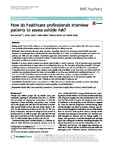How do healthcare professionals interview patients to assess suicide risk?
| dc.contributor.author | McCabe, R | |
| dc.contributor.author | Sterno, I | |
| dc.contributor.author | Priebe, S | |
| dc.contributor.author | Barnes, R | |
| dc.contributor.author | Byng, Richard | |
| dc.date.accessioned | 2017-08-10T11:01:16Z | |
| dc.date.available | 2017-08-10T11:01:16Z | |
| dc.date.issued | 2017-12 | |
| dc.identifier.issn | 1471-244X | |
| dc.identifier.issn | 1471-244X | |
| dc.identifier.other | 122 | |
| dc.identifier.uri | http://hdl.handle.net/10026.1/9719 | |
| dc.description.abstract |
BACKGROUND: There is little evidence on how professionals communicate to assess suicide risk. This study analysed how professionals interview patients about suicidal ideation in clinical practice. METHODS: Three hundred nineteen video-recorded outpatient visits in U.K. secondary mental health care were screened. 83 exchanges about suicidal ideation were identified in 77 visits. A convenience sample of 6 cases in 46 primary care visits was also analysed. Depressive symptoms were assessed. Questions and responses were qualitatively analysed using conversation analysis. χ 2 tested whether questions were influenced by severity of depression or influenced patients' responses. RESULTS: A gateway closed question was always asked inviting a yes/no response. 75% of questions were negatively phrased, communicating an expectation of no suicidal ideation, e.g., "No thoughts of harming yourself?". 25% were positively phrased, communicating an expectation of suicidal ideation, e.g., "Do you feel life is not worth living?". Comparing these two question types, patients were significantly more likely to say they were not suicidal when the question was negatively phrased but were not more likely to say they were suicidal when positively phrased (χ 2 = 7.2, df = 1, p = 0.016). 25% patients responded with a narrative rather than a yes/no, conveying ambivalence. Here, psychiatrists tended to pursue a yes/no response. When the patient responded no to the gateway question, the psychiatrist moved on to the next topic. A similar pattern was identified in primary care. CONCLUSIONS: Psychiatrists tend to ask patients to confirm they are not suicidal using negative questions. Negatively phrased questions bias patients' responses towards reporting no suicidal ideation. | |
| dc.format.extent | 122- | |
| dc.format.medium | Electronic | |
| dc.language | en | |
| dc.language.iso | en | |
| dc.publisher | Springer Science and Business Media LLC | |
| dc.subject | Suicide | |
| dc.subject | Risk | |
| dc.subject | Communication | |
| dc.subject | Assessment | |
| dc.subject | Conversation analysis | |
| dc.subject | Mixed methods | |
| dc.subject | Mental health care | |
| dc.title | How do healthcare professionals interview patients to assess suicide risk? | |
| dc.type | journal-article | |
| dc.type | Journal Article | |
| plymouth.author-url | https://www.webofscience.com/api/gateway?GWVersion=2&SrcApp=PARTNER_APP&SrcAuth=LinksAMR&KeyUT=WOS:000398423500001&DestLinkType=FullRecord&DestApp=ALL_WOS&UsrCustomerID=11bb513d99f797142bcfeffcc58ea008 | |
| plymouth.issue | 1 | |
| plymouth.volume | 17 | |
| plymouth.publication-status | Published online | |
| plymouth.journal | BMC Psychiatry | |
| dc.identifier.doi | 10.1186/s12888-017-1212-7 | |
| plymouth.organisational-group | /Plymouth | |
| plymouth.organisational-group | /Plymouth/Faculty of Health | |
| plymouth.organisational-group | /Plymouth/Faculty of Health/Peninsula Medical School | |
| plymouth.organisational-group | /Plymouth/REF 2021 Researchers by UoA | |
| plymouth.organisational-group | /Plymouth/REF 2021 Researchers by UoA/UoA03 Allied Health Professions, Dentistry, Nursing and Pharmacy | |
| plymouth.organisational-group | /Plymouth/Research Groups | |
| plymouth.organisational-group | /Plymouth/Research Groups/FoH - Community and Primary Care | |
| plymouth.organisational-group | /Plymouth/Research Groups/Institute of Health and Community | |
| plymouth.organisational-group | /Plymouth/Research Groups/Institute of Translational and Stratified Medicine (ITSMED) | |
| plymouth.organisational-group | /Plymouth/Research Groups/Institute of Translational and Stratified Medicine (ITSMED)/CCT&PS | |
| plymouth.organisational-group | /Plymouth/Research Groups/Plymouth Institute of Health and Care Research (PIHR) | |
| plymouth.organisational-group | /Plymouth/Users by role | |
| plymouth.organisational-group | /Plymouth/Users by role/Academics | |
| dc.publisher.place | England | |
| dcterms.dateAccepted | 2017-01-19 | |
| dc.identifier.eissn | 1471-244X | |
| dc.rights.embargoperiod | No embargo | |
| rioxxterms.versionofrecord | 10.1186/s12888-017-1212-7 | |
| rioxxterms.licenseref.uri | http://www.rioxx.net/licenses/all-rights-reserved | |
| rioxxterms.licenseref.startdate | 2017-12 | |
| rioxxterms.type | Journal Article/Review | |
| plymouth.oa-location | http://10.0.4.162/s12888-017-1212-7 |


